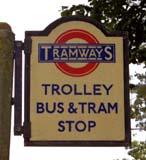 |
My Local Tram RouteWritten by your Webmaster, David Bradley |
There are several pages to this section [ 1 | 2 | 3 | 4 ]
![]()
 |
My Local Tram RouteWritten by your Webmaster, David Bradley |
There are several pages to this section [ 1 | 2 | 3 | 4 ]
![]()
 |
| Trolleybus on Route 542 arriving at West Croydon Station |
Virgin's G1 class bus introduced on route 542 in February 1999 pictured in Station Road, West Croydon.
Tramlink uses pantograph current collection and so the trolleybus overhead is 150mm higher than the contact wires of the
trams to prevent "shorting out" the twin trolleybus overhead.
This new class of trolleybus necessitated that the pavement was raised to the level of the floor of the trolleybus,
buried cables guide each vehicle by induction to within 5cm of the kerb, enabling easy access for wheel
chair passengers.
Virgin gained the 516/518 and 542 franchise in 1997 because they were prepared to revive the aborted
extension to Crystal Palace from Thornton Heath. However the trolleybus infrastructure of support poles and overhead
wiring, although in generally good condition, had reached the end of their safe service life and required complete
refurbishment. A combination of Green
Fuel Tax Credits and a EU Grant enabled this work to be put in hand immediately. The new overhead contains a fibre
optic core to carry communications traffic that provides an array of passenger communication facilities at each bus
stop and also low cost telecommunication services to properties within 50 metres of each bus stop.
Each bus stop now has visual display units showing a local map overlaid with the actual location of each trolleybuses
serving that stop with its estimated time of arrival. Part of the screen also provides scrolling messages and
advertisements.
The recent predestinisation of North End has re-routed the former tram routes via Station Road, Wellesley Road and George
Street to re-join its former route to South Croydon Depot. The reverse direction uses Katherine Street instead of George
Street. Central Croydon now has the only trolleybus / tram pantograph intersections in the UK.
The aging fleet of Z6's were replaced in January 1999 with articulated single decker low floor trolleybuses, designated
class G1, of a proven design that will also be used in Virgin's franchise area in Liverpool.
 |
| Not required |
[By coincidence, class G1 was the designated class for single deck vehicles in London which would
have served Alexandra Palace. They never got off the drawing board, but London's classifications did jump from F-H.] The
buses have a number of novel technical features, the most notable being computerised boom returning to the roof of the
trolleybus in the event of a dewirement. Manual placing of the booms back on the overhead by the driver is still
necessary!
The distinctive grill on the front of the trolleybus sports an 'over specified' air condition unit that can drop
the interior temperature down to 12°C, which can be quite cold for some passengers. The
Multos Mass Transit Ticket less System
[which has virtually eliminated fare evasion] sends real time accurate passenger statistics back to Virgin's
Headquarters and Depot which was built on the site of the former Addiscombe Railway terminus. Here a new gas turbine
generating system provides power supplies to Virgin's south London routes together with local district heating.
Each trolleybus has a Royal Mail Postbox, the contents of which are emptied each time it passes the main sorting office at
East Croydon. The 5p surcharge on each letter represents particularly good value as most items processed are delivered
the same day. Royal Mail subsidises the all night service on route 542 since many of the sorting office staff commute
from along its route.
Will trolleybuses serve your locality in the future? Probably, and for the most up-to-date information visit the
TBus site.
The advantages of electric vehicles coming your way are: |
|
|
To you, the passenger: Zero pollution emissions in the streets Lowest possible noise levels To the public generally: Lowest possible emissions into the environment as a whole Lowest possible consumption of non renewable resources Lowest possible release of greenhouse gases like CO2 |
To the operator: High mechanical reliability and efficiency Long service life No idling motor losses Greater acceleration and hill climbing performance Lower power costs Lower maintenance costs |